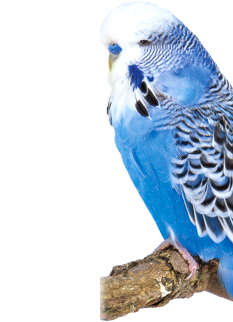Profiles
Budgerigar
This little chatterbox is about 18cm long from its beak to the tip of its long tail feathers. In the wild this delightful creature is green, with a yellow head, black-yellow wavy markings on the neck and back and wavy markings on the wings. In the male, the nasal area is bluish, in the female it is brown to beige - otherwise it isn’t possible to distinguish between the sexes by appearance.
Maintenance:
The budgerigar is the most popular of all domestic birds worldwide. It lives sociably and is exceptionally tolerant of its own kind and other birds. Not all budgies like to bathe. Leave a wet lettuce leaf or large wet deciduous tree leaves in the cage, and the birds will use them to care for their plumage.
Special seed mixtures serve as a staple diet, corresponding to the natural food of this Australian bird. TRILL® budgerigar food, honey sticks and millet spray for example are good feeds for your budgie. It is also a good idea to put sand either on the cage floor or in an extra dish. Budgerigars brood in nooks and crannies or in nesting boxes. They do not build nests, and the female lays her eggs on the floor of the selected place. It broods alone and is cared for by the male. The young hatch after 18 days, stay for 30 to 35 days in the nesting box and are independent two weeks later.
Characteristics:
Name: Budgerigar
Family: Parrot
Origin: Dry areas of Australia
Size: Small
Care: Undemanding
Temperament: Friendly, quickly tamed, curious, sociable
Call: Pleasant chirping
Features: Learns to imitate speech
